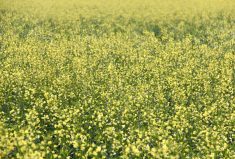MarketsFarm — Price increases for feed barley and wheat in Western Canada have caused more feeders to look elsewhere for sustenance for their livestock.
Prices over the last year have shot up 25 to 40 per cent, according to Prairie Ag Hotwire.
“Any time you run into a high-priced commodity market, the cost of feeding starts to climb,” said Brandon Motz, co-owner and sales manager of CorNine Commodities at Lacombe, Alta.
“There are always cheaper options being looked at… We’ve definitely seen an increase in byproducts and searching for alternative feeds.”
Read Also

Alberta crop conditions improve: report
Varied precipitation and warm temperatures were generally beneficial for crop development across Alberta during the week ended July 8, according to the latest provincial crop report released July 11.
Barry Yaremcio, owner and founder of Yaremcio Ag Consulting at Stettler, Alta., said oats and hay are two of the most common alternative feeds. Other feed options include peas, lentils, fababeans, sunflower seeds, cull potatoes, rye, triticale and screenings.
The challenge for feedlots is to provide a mixture sufficient for the nutritional needs of their animals. Cattle can’t consume too many cereal grains due to the risk of rumen acidosis. In Alberta, due to a lack of protein content in last year’s forages, cow-calf feeders are looking for more grains and seeds.
“Sunflower seeds: 22 per cent protein; peas: 24 per cent; lentils: 21 per cent; chickpeas: 24 per cent,” Yaremcio said. “There’s a lot of options out there to get protein levels up (without) having to feed barley, canola meal or soybean meal, which are very expensive right now.”
A five cent per pound reduction in feeding costs to a 1,400-lb. animal would result in cost savings of at least $75 per head, according to Yaremcio. However, it depends on the animal’s feeding program.
“Are they trying to maintain the animal’s weight? Are they growing the animal at a certain pound per head per day?” Motz said.
He also warned that higher demand for alternative feeds can result in prices rising to a point where they are no longer financially viable. With signs pointing to a dry summer in Western Canada and other commodity prices remaining high, prices for feed grains could stay elevated into the next crop year.
“The weather’s being watched. The acres are being watched. We have three or four months until new crop start to come off and we’ll have a better idea by July what the crop will look like, which will paint the picture in the fall.”
— Adam Peleshaty reports for MarketsFarm from Stonewall, Man.

















